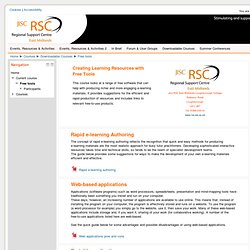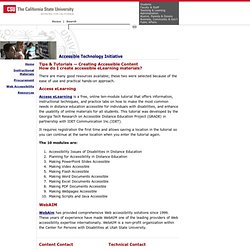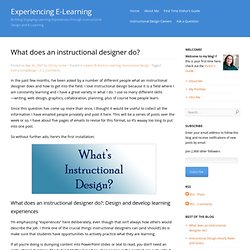

0510ijmit02.pdf. Creating e-learning resources with free tools: Jisc RSC East Midlands Moodle 2. The software listed below includes tools highlighted in a recent RSC survey of what learning providers are using, together with some additional recommendations of our own.

Picasa Picasa is a photo editing application from Google. It is simple to use and allows you to make a range of adjustment to improve and modify still images. It also acts as a browser for your image collections, helping you to find what you are looking for quickly. There is also an image sharing feature You can download Picasa 3 here: Picasa is fairly self-explanatory, but there is a detailed guide to its features here. Creating Assessible Content - eLearning Materials. How do I create accessible eLearning materials?

There are many good resources available; these two were selected because of the ease of use and practical hands-on approach. Access eLearning Access eLearning is a free, online ten-module tutorial that offers information, instructional techniques, and practice labs on how to make the most common needs in distance education accessible for individuals with disabilities, and enhance the usability of online materials for all students. This tutorial was developed by the Georgia Tech Research on Accessible Distance Education Project (GRADE) in partnership with IDET Communication Inc. (IDET). It requires registration the first time and allows saving a location in the tutorial so you can continue at the same location when you enter the tutorial again.
The 10 modules are: WebAIM WebAim has provided comprehensive Web accessibility solutions since 1999. Table of Contents - 2011BestPractices.pdf. Firstprinciplesbymerrill.pdf. The Accidental Instructional Designer by Cammy Bean. “You may have found your way into this field by accident, but it is what you’re doing in the here and now, so you might as well do it well and with great passion and delight.”

When you were a kid, what did you want to be when you grew up? A doctor? A teacher? A firefighter? An eLearning instructional designer (ID) doing corporate training? As a teenager and young adult, I set my sights on becoming a writer or a teacher. Let’s get personal. What does an instructional designer do? In the past few months, I’ve been asked by a number of different people what an instructional designer does and how to get into the field.

I love instructional design because it is a field where I am constantly learning and I have a great variety in what I do. I use so many different skills—writing, web design, graphics, collaboration, planning, plus of course how people learn. Since this question has come up more than once, I thought it would be useful to collect all the information I have emailed people privately and post it here. This will be a series of posts over the week or so. I have about five pages of emails to revise for this format, so it’s waaay too long to put into one post. So without further ado, here’s the first installation:
Table of Contents - 2011BestPractices.pdf. Instruc.Design.Smith.Ragan.pdf. Table of Contents - 2011BestPractices.pdf. Review of Clark Quinn’s New Book: Revolutionize Learning and Development: Performance and Innovation Strategy for the Information Age. One of my favorite people in the workplace-learning space is Clark Quinn.

Smart, passionate, and research-based, Clark has been consulting on learning and learning technology for decades. We worked on the Serious eLearning Manifesto together. We attempted—and failed—to build a community of workplace learning thought leaders. We commiserate frequently. I feel that I know some of what is in Clark’s heart. With publication of his new book, Revolutionize Learning and Development, Clark shares his unbridled passion for our field.
Clark loves what we do. Clark comes to his wisdom based on years of immersion in the learning research and working on practical learning-design issues. In the book, Clark highlights the need for us to redouble our focus on two areas, performance consulting and development facilitation. Nuggets From the Book: “Our species has in many ways survived because we learned how to physically augment our resources.” Critiques of Our Current Practices: Criticism: Summary: Clark Training & Consulting - Books. How to become an instructional designer. A lot of people ask me how they could become instructional designers.

Here’s some advice from my perspective, followed by links for other perspectives. All of this applies to instructional design in the business world, not academia or K-12 education. It’s probably most applicable to people in the US. Get experience in your current job The first step can be to get more instructional design experience at your current job, if possible. Another approach is to simply create what the organization needs, if you have the time. Another approach is to politely offer to overhaul an existing course or other learning intervention that isn’t working or that people complain about, even if has nothing to do with your job description.
Instructional Design Models and Methods. Instructional Design Models and Methods "Models, like myths and metaphors, help us to make sense of our world.

Whether derived from whim or from serious research, a model offers its user a means of comprehending an otherwise incomprehensible problem. An instructional design model gives structure and meaning to an I.D. problem, enabling the would-be designer to negotiate her design task with a semblance of conscious understanding. Models help us to visualize the problem, to break it down into discrete, manageable units.